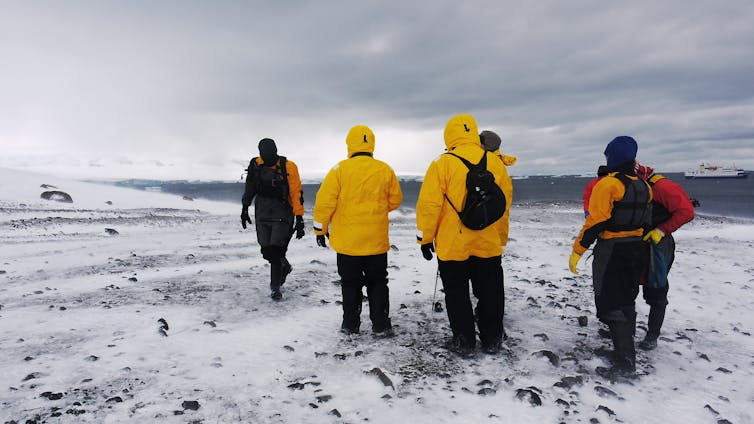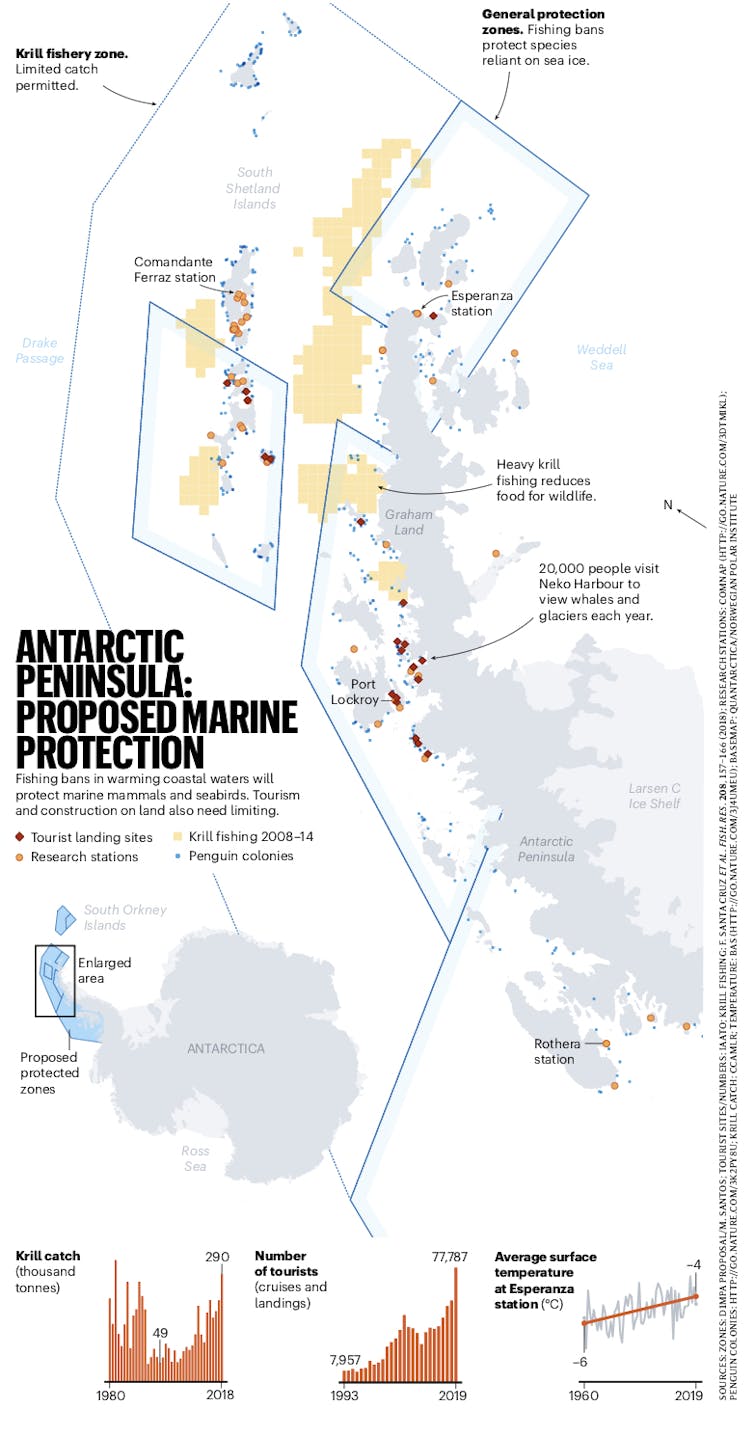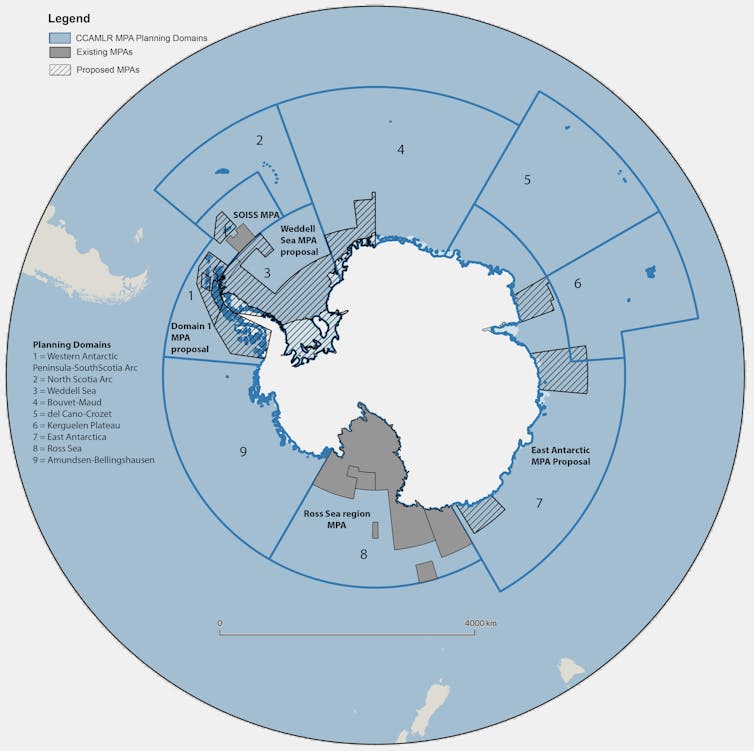From The Conversation by Marissa Parrott, Carlyn Hogg, Cassandra Brooks, Justine Shaw & Melissa Cristina Marquez
Antarctica, the world’s last true wilderness, has been protected by an international treaty for the last 60 years.
Just 5% of the Southern Ocean is protected, leaving biodiversity hotspots exposed to threats from human activity.
The Western Antarctic Peninsula, the northernmost part of the continent and one of its most biodiverse regions, is particularly vulnerable.
In an article published in Nature today, we join more than 280 women in STEMM(science, technology, engineering, maths and medicine) from the global leadership initiative Homeward Bound to call for the immediate protection of the peninsula’s marine environment, through the designation of a marine protected area.
Our call comes ahead of a meeting, due in the next fortnight, of the international group responsible for establishing marine protected areas in the Southern Ocean.
Threats on the peninsula
The Southern Ocean plays a vital role in global food availability and security, regulates the planet’s climate and drives global ocean currents.
Climate change threatens to unravel the Southern Ocean ecosystem as species superbly adapted to the cold struggle to adapt to warmer temperatures.
The peninsula is also the most-visited part of Antarctica, thanks to its easy access, dramatic beauty, awe-inspiring wildlife and rich marine ecosystems.
Eighteen nations have science facilities on the Antarctic Peninsula, the highest concentration of research stations anywhere on the continent.
Another big threat to biodiversity in the peninsula is the commercial fishing of Antarctic krill, a small, shrimp-like crustacean which is the cornerstone of life in this region.
A cornerstone of life
Krill is a foundation of the food chain in Antarctica, with whales, fish, squid, seals and Adélie and gentoo penguins all feeding on it.
But as sea ice cover diminishes, more industrial fishing vessels can encroach on penguin, seal and whale foraging grounds, effectively acting as a competing super-predator for krill.
In the past 30 years, colonies of Adélie and Chinstrap penguins on the Antarctic Peninsula have declined by more than 50% due to reduced sea ice and krill harvesting.
 Krill is a vital part of the food web in Antarctica.
Krill is a vital part of the food web in Antarctica.The krill catch here has more than tripled from 88,800 tonnes in 2000 to almost 400,000 tonnes in 2019 — the third-largest krill catch in history and a volume not seen since the 1980s.
How do we save it?
This can be done by establishing a marine protected area (MPA) in the region, which would limit or prohibit human activities such as commercial fishing.
The proposed MPA is an excellent example of balancing environmental protection with commercial interests.
Nature 586: 496-499 22 October 2020, Author provided
The second is a krill fishery zone, allowing for a precautionary management approach to commercial fishing and keeping some fishing areas open for access.
The proposed MPA would stand for 70 years, with a review every decade so zones can be adjusted to preserve ecosystems.
No more disastrous delays
The commission is made up of 25 countries and the European Union. In its upcoming meeting, the proposed MPA will once again be considered.
A map of the current and proposed marine protected areas under consideration. Cassandra Brooks, Author provided
In fact, for eight consecutive years, the proposal for a marine park in Eastern Antarctica has failed. Delays like this are potentially disastrous for the fragile ecosystem.
Protecting the peninsula is the most pressing priority due to rising threats, but the commission should adopt all three to fulfil their 2002 commitment to establishing an MPA network in Antarctica.
If all three were established, then more than 3.2 million square kilometres of the Southern Ocean would be protected, giving biodiversity a fighting chance against the compounding threats of human activity in the region.
Links :
- The Conversation : Antarctica has lost 3 trillion tonnes of ice in 25 years. Time is running out for the frozen continent / Why marine protected areas are often not where they should be / Anatomy of a heatwave: how Antarctica recorded a 20.75°C day last month / Climate change threatens Antarctic krill and the sea life that depends on it / Australia wants to build a huge concrete runway in Antarctica. Here's why that's a bad idea



No comments:
Post a Comment